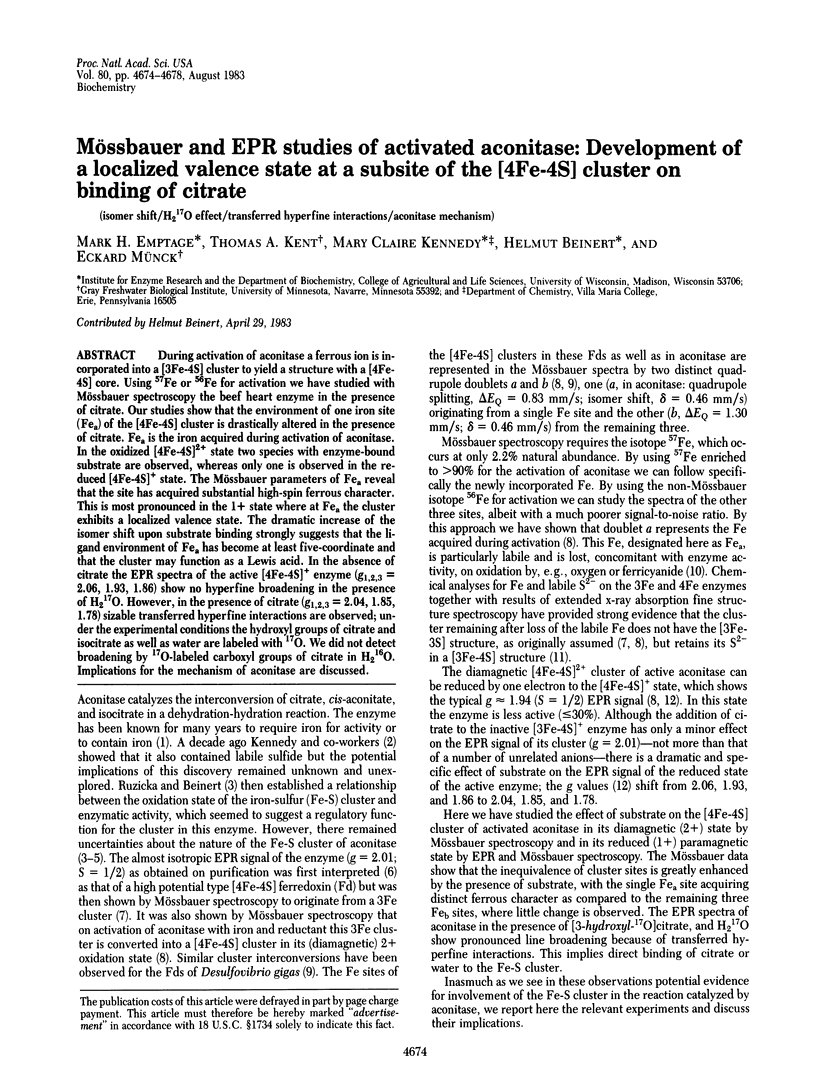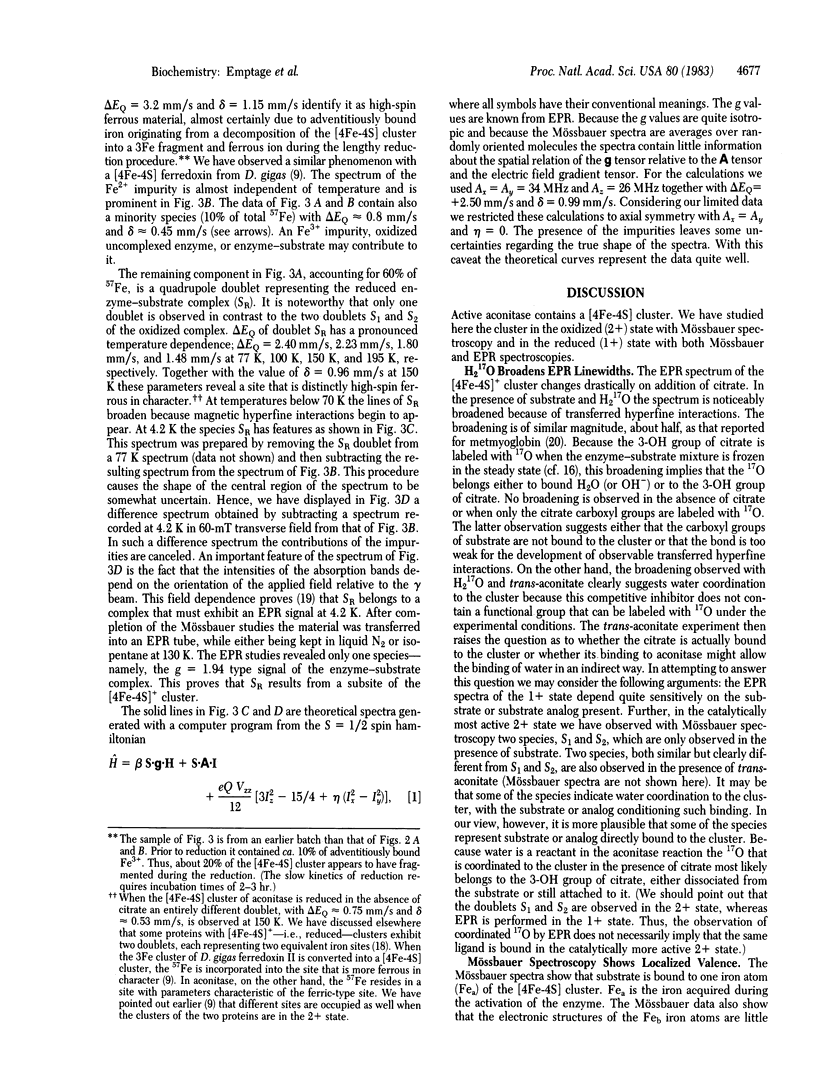Abstract
During activation of aconitase a ferrous ion is incorporated into a [3Fe-4S] cluster to yield a structure with a [4Fe-4S] core. Using 57Fe or 56Fe for activation we have studied with Mössbauer spectroscopy the beef heart enzyme in the presence of citrate. Our studies show that the environment of one iron site (Fea) of the [4Fe-4S] cluster is drastically altered in the presence of citrate. Fea is the iron acquired during activation of aconitase. In the oxidized [4Fe-4S]2+ state two species with enzyme-bound substrate are observed, whereas only one is observed in the reduced [4Fe-4S]+ state. The Mössbauer parameters of Fea reveal that the site has acquired substantial high-spin ferrous character. This is most pronounced in the 1+ state where at Fea the cluster exhibits a localized valence state. The dramatic increase of the isomer shift upon substrate binding strongly suggests that the ligand environment of Fea has become at least five-coordinate and that the cluster may function as a Lewis acid. In the absence of citrate the EPR spectra of the active [4Fe-4S]+ enzyme (g1,2,3 = 2.06, 1.93, 1.86) show no hyperfine broadening in the presence of H2 17O. However, in the presence of citrate (g1,2,3 = 2.04, 1.85, 1.78) sizable transferred hyperfine interactions are observed; under the experimental conditions the hydroxyl groups of citrate and isocitrate as well as water are labeled with 17O. We did not detect broadening by 17O-labeled carboxyl groups of citrate in H2 16O. Implications for the mechanism of aconitase are discussed.
Full text
PDF




Selected References
These references are in PubMed. This may not be the complete list of references from this article.
- Beinert H., Emptage M. H., Dreyer J. L., Scott R. A., Hahn J. E., Hodgson K. O., Thomson A. J. Iron-sulfur stoichiometry and structure of iron-sulfur clusters in three-iron proteins: evidence for [3Fe-4S] clusters. Proc Natl Acad Sci U S A. 1983 Jan;80(2):393–396. doi: 10.1073/pnas.80.2.393. [DOI] [PMC free article] [PubMed] [Google Scholar]
- Henson C. P., Cleland W. W. Purification and kinetic studies of beef liver cytoplasmic aconitase. J Biol Chem. 1967 Sep 10;242(17):3833–3838. [PubMed] [Google Scholar]
- Kennedy S. C., Rauner R., Gawron O. On pig heart aconitase. Biochem Biophys Res Commun. 1972 May 26;47(4):740–745. doi: 10.1016/0006-291x(72)90554-2. [DOI] [PubMed] [Google Scholar]
- Kent T. A., Dreyer J. L., Kennedy M. C., Huynh B. H., Emptage M. H., Beinert H., Münck E. Mössbauer studies of beef heart aconitase: evidence for facile interconversions of iron-sulfur clusters. Proc Natl Acad Sci U S A. 1982 Feb;79(4):1096–1100. doi: 10.1073/pnas.79.4.1096. [DOI] [PMC free article] [PubMed] [Google Scholar]
- Kent T. A., Spartalian K., Lang G., Yonetani T., Reed C. A., Collman J. P. High magnetic field Mössbauer studies of deoxymyoglobin, deoxyhemoglobin, and synthetic analogues. Biochim Biophys Acta. 1979 Oct 24;580(2):245–258. doi: 10.1016/0005-2795(79)90137-5. [DOI] [PubMed] [Google Scholar]
- Kurtz D. M., Holm R. H., Ruzicka F. J., Beinert H., Coles C. J., Singer T. P. The high potential iron-sulfur cluster of aconitase is a binuclear iron-sulfur cluster. J Biol Chem. 1979 Jun 25;254(12):4967–4969. [PubMed] [Google Scholar]
- Massey V., Hemmerich P. Photoreduction of flavoproteins and other biological compounds catalyzed by deazaflavins. Biochemistry. 1978 Jan 10;17(1):9–16. doi: 10.1021/bi00594a002. [DOI] [PubMed] [Google Scholar]
- Moura J. J., Moura I., Kent T. A., Lipscomb J. D., Huynh B. H., LeGall J., Xavier A. V., Münck E. Interconversions of [3Fe-3S] and [4Fe-4S] clusters. Mössbauer and electron paramagnetic resonance studies of Desulfovibrio gigas ferredoxin II. J Biol Chem. 1982 Jun 10;257(11):6259–6267. [PubMed] [Google Scholar]
- Münck E., Debrunner P. G., Tsibris J. C., Gunsalus I. C. Mössbauer parameters of putidaredoxin and its selenium analog. Biochemistry. 1972 Feb 29;11(5):855–863. doi: 10.1021/bi00755a027. [DOI] [PubMed] [Google Scholar]
- Münck E. Mössbauer spectroscopy of proteins: electron carriers. Methods Enzymol. 1978;54:346–379. doi: 10.1016/s0076-6879(78)54023-8. [DOI] [PubMed] [Google Scholar]
- Rose I. A., O'Connell E. L. Mechanism of aconitase action. I. The hydrogen transfer reaction. J Biol Chem. 1967 Apr 25;242(8):1870–1879. [PubMed] [Google Scholar]
- Ruzicka F. J., Beinert H. A mitochondrial iron protein with properties of a high-potential iron-sulfur protein. Biochem Biophys Res Commun. 1974 Jun 4;58(3):556–563. doi: 10.1016/s0006-291x(74)80456-0. [DOI] [PubMed] [Google Scholar]
- Ruzicka F. J., Beinert H. The soluble "high potential" type iron-sulfur protein from mitochondria is aconitase. J Biol Chem. 1978 Apr 25;253(8):2514–2517. [PubMed] [Google Scholar]
- Sands R. H., Dunham W. R. Spectroscopic studies on two-iron ferredoxins. Q Rev Biophys. 1974 Nov;7(4):443–504. doi: 10.1017/s0033583500001517. [DOI] [PubMed] [Google Scholar]
- Shaw R. W., Rife J. E., O'Leary M. H., Beinert H. Oxidation of reduced cytochrome c oxidase with 18O2. A search for mu-oxo-bridged metal species in the oxidized enzyme. J Biol Chem. 1981 Feb 10;256(3):1105–1107. [PubMed] [Google Scholar]
- Vuk-Pavlović S., Siderer Y. Probing axial ligands in ferric haemoproteins: an ESR study of myoglobin and horseradish peroxidase in H217O. Biochem Biophys Res Commun. 1977 Dec 7;79(3):885–889. doi: 10.1016/0006-291x(77)91193-7. [DOI] [PubMed] [Google Scholar]
- Zimmermann R., Münck E., Brill W. J., Shah V. K., Henzl M. T., Rawlings J., Orme-Johnson W. H. Nitrogenase X: Mössbauer and EPR studies on reversibly oxidized MoFe protein from Azotobacter vinelandii OP. Nature of the iron centers. Biochim Biophys Acta. 1978 Dec 20;537(2):185–207. doi: 10.1016/0005-2795(78)90504-4. [DOI] [PubMed] [Google Scholar]


